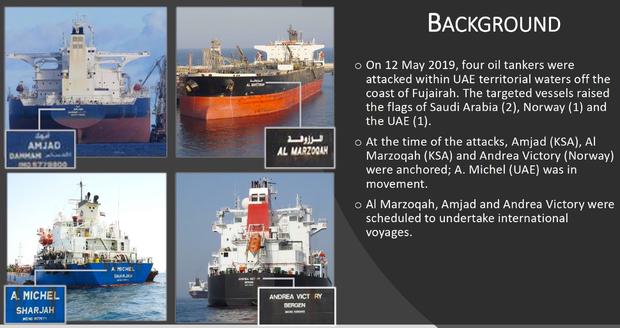"While investigations are still ongoing, these facts are strong indications that the four attacks were part of a sophisticated and coordinated operation carried out by an actor with significant operational capacity, most likely a state actor," the U.N. was told on Thursday.
The photos of the tankers from Norway, the United Arab Emirates, and Saudi Arabia were taken by underwater divers of the Emirates, which led the investigation with support from U.S. military experts. The photos were shown during an informal briefing on Thursday to nations of the U.N. Security Council and to a small group of reporters, including CBS News.
U.S. military officials and the White House have definitively laid blame for the attack on Iran, as has close U.S. ally and Iranian arch-rival Saudi Arabia.
Norway, the Emirates and Saudi Arabia warned world powers said at the briefing that they wished to stress "that the attacks endangered international commercial navigation and the security of global energy supplies, and threatened international peace and security."
The attacks took place in the Gulf of Oman, "within UAE territorial waters less than 12 nautical miles from the UAE coastline," the investigation states. Its primary conclusions will be shared with the International Maritime Organization (IMO) and other intelligence agencies.
The reasoning
Explaining its conclusion that a nation was likely behind the attack, rather than a criminal or terrorist group, for instance, the investigation found:- The attacks required intelligence capabilities for the deliberate selection of four oil tankers from among almost 200 vessels of all types that lay at anchor off Fujairah at the time of the attacks. One of the targets was at the opposite end of the anchorage area from the other ships, which indicates that these were premeditated strikes, rather than targets picked at random.
- The attacks likely required the positive identification of these pre-selected targets by the operatives carrying out the attacks.
- The attacks required trained divers; the explosive charges were placed with a high degree of precision under the waterline, in ways that were designed to incapacitate the ships without sinking them or detonating their cargoes – indicating minute knowledge of the design of the targeted ships.
- The attacks required a high degree of coordination among what most likely were several teams of operatives. This included the timed detonation of all four explosive charges, sequenced within less than an hour.
Tension in the Gulf
The attacks on the oil tankers came amid a sharp escalation of tension between the U.S. and Iran.American officials told CBS News senior national security correspondent David Martin last month that the initial assessment of a U.S. team sent to investigate the incidents was that Iran or Iranian-backed proxies had used explosives to blow holes in the four ships.
On Thursday, the Associated Press quoted Marine Gen. Frank McKenzie, commander of U.S. forces in the Middle East, as saying Iran appeared to have taken a "step back and recalculate" in response to the U.S. military buildup in the Persian Gulf region, but he also cautioned there was no conclusion that Iran had abandoned the alleged plans for potential attacks against American interests.



No comments:
Post a Comment